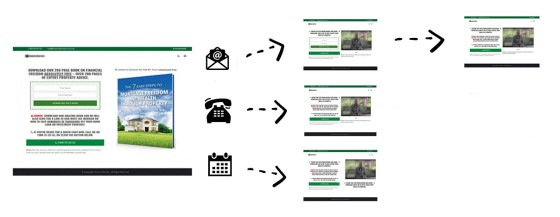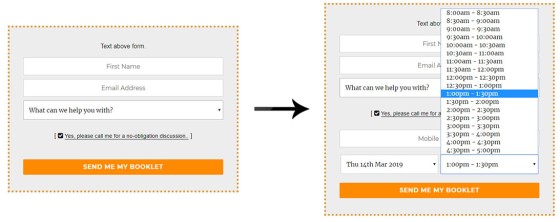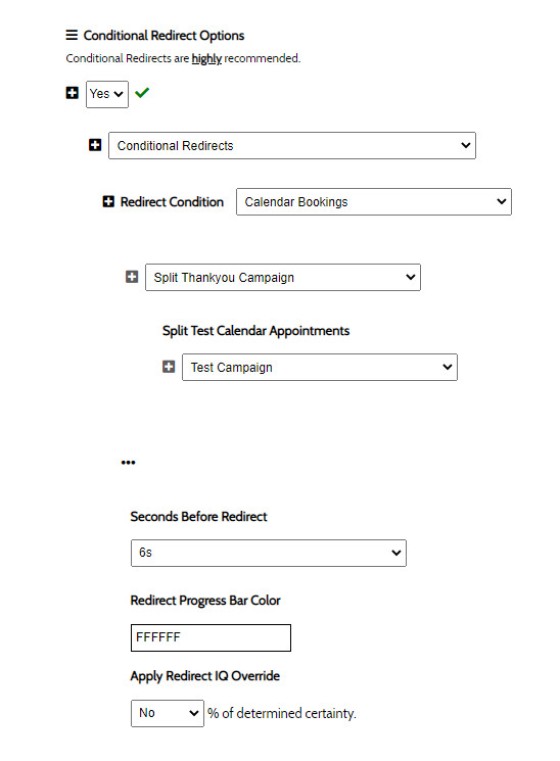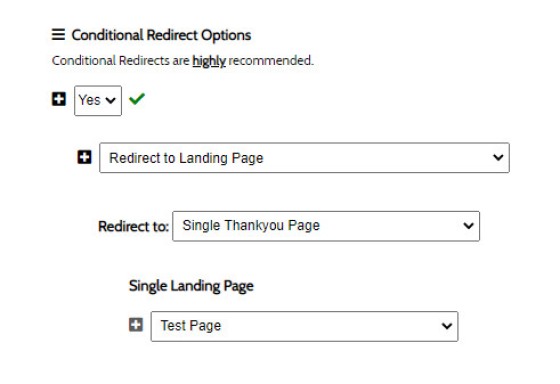In a number of articles we've published to our website recently we've discussed how every page on your website is a type of landing page, how to include a conversion opportunity on every page, and how our integrated calendar means that the single subscription form on each page is more effective and powerful than most paid landing pages used by virtually of your competition. Adding value to the on-page subscription is the optional escalation of forms (and landing panels) which further shapes a funnel participant's journey. These page elements are mandatory for a high-converting website. The conditional redirections we introduce on this page are a default and option component of every form you create, and they'll vastly improve upon your ability to convert those that subscribe to any of your marketing assets.
The conditional redirect concept was introduced previously in an article titled "The First Landing Page Funnel Email", and the value of the second page in a subscription sequence was detailed in an article titled "Making The Second ‘Thank You’ Landing Page Great Again". Both articles cover the 'redirect' principles in brief but the operation of the redirections were performed via our retired plugin. This article introduces how Yabber  handles conditional redirects, and why they're a vital component of your marketing funnel experience (but a small part of our broader conditional and escalating methodology).
handles conditional redirects, and why they're a vital component of your marketing funnel experience (but a small part of our broader conditional and escalating methodology).
The video discussion below is used to introduces Conditional Redirections to participants of our funnel experience.
We go a little off-script and discuss various other concepts.
Different Strokes For Different Folks
One of four actions apply for any page subscription and we consider each of these interactions in a unique way (these are on-page interactions and do not include a direct phone call). Those interactions are as follows:
- A Calendar Booking by way of the integrated calendar form.
- A Phone number only. No calendar date selected or supplied.
- Email subscription only, usually associated with the download of a lead magnet or event (webinar) registration.
- No action or bounce (in the case of landing pages).
Since every user expresses a varying degree of commitment we should address their inquiry in a unique and more personal manner, and we must send them to a second page with the purpose of setting further expectation or escalating the experience (the 'Second Page' is the Marketing God's gift to any business).
It's the conditional second page where our landing system further sets itself apart from the generic nonsense that has established itself as a marketing norm. Your competitors are usually using the second page to make a case for further contact, with the third and fourth page making the clumsy third-party calendar plugin available. We know that each page view or keystroke objectively decreases conversions, and this means we're obligated to minimise the effort required to submit a single form. So, what we accomplish in one page takes others up to five pages to achieve, and 'the other guys' have done so poorly without actually providing value to the experience.
The funnel is used to qualify you - not the client. And the easiest way of qualifying yourself in a blur of competition is to stand out from the sea of mediocrity. Your experience will set you apart.
Since we provide an integrated calendar on virtually every form (with the hidden calendar usually hidden behind an unobtrusive checkbox) we're able to assess each interaction based on the commitment the user demonstrates. In making the absolute most out of that amazingly powerful second page, we can send telephone, calendar, and basic lead subscribers to different pages. In the case of the latter group we may present an open calendar inviting them into a discussion (and it's one of the only times we'll 'open' a calendar within the funnel).
Pictured: An example landing page showing the different directions the initial first-page subscription might take us. In making the most of the second page, and in order to actually escalate the experience based on known interest, we (optionally) send the user to a page most likely to escalate or convert. The second page is one of the most wasted resources in the marketing world.
Of course, the conditional experience is only made possible by way of our fully-integrated calendar booking form.
Pictured: The open and closed calendar. Note that the design has changed a little since this screenshot was taken. A more up-to-date and living example should reside at the bottom of this page. The calendar obviously integrates with Microsoft Outlook. This single and simple form enables a great deal of conditional content to take shape.
Not all leads are created equal, and nor should their experience by treated equally.
Creating Creating Redirections
For each form interaction, the redirect may simply redirect to a single URL (as you're probably familiar with). However, as your marketing matures and you look at increasing upon your landing conversions or general Page Subscription Ratio (PSR), you'll incrementally start to include conditional redirects for specific forms (usually associated with high-value landing pages). Later, as you start to garnish large amounts of traffic, instead of creating conditional redirects to a single conditional page you have the option of redirecting to groups of split conditional pages so you're able to test the effectiveness of one page against a group of others. The system is as simple or as advanced as you want it to be.
The redirects are defined at the form level when creating a specific subscription experience.
Pictured: In the example shown we're creating a redirect for the 'Calendar Booking' condition. In this case we're redirecting to a split group of pages. Note that we also have the option to define the colour of the progress bar shown after the 'Success' message is shown, and before the page redirects. Remember, as your form escalates the redirections will change to a new location, thus creating any number of funnel pathways.
Pictured: Image shows a redirection to a single page.
The Redirect IQ function should be used to send users to a winning split second page, or a completely different page, as determined by BeNet's AI engine. To force the second page without AI-based interference, simply select 'No' and the inference API logic will be ignored. If no redirect is to be actioned, simply select the redirect panel to 'No' - this will show the thank you 'Success' message only and will not redirect to any other page.
Conclusion
Conditional redirects may be applied to any form or landing panel in any location, and escalation also applies in all cases except for dedicated landing pages.
The conditional redirects and form behaviour is just one small part of the broad conditional features integrated into your default website. While you don't have to use all the features early on in your marketing efforts you'll be armed with the most powerful website made available to the finance space with features and intelligence unrivalled by your competitors.
The integration of your website into your marketing funnel is at the core of your online marketing experience. If you're going it alone and building a DIY solution we'd only offer one piece of advice: never host a landing page or any marketing asset on a third-party service. As we mentioned earlier, the commonplace practice represents something less than worst-practice and it'll have a debilitating effect on your broader marketing efforts. Certainly, never ever send Facebook traffic to a third-party resource.
Good marketing and high conversions are made up of incremental changes to your online presence in multiple areas - not just your website. Yabber  automates and manages your entire marketing and relationship programs; it is, without question, the leading and most cost-effective marketing experience made available to the industry.
automates and manages your entire marketing and relationship programs; it is, without question, the leading and most cost-effective marketing experience made available to the industry.












